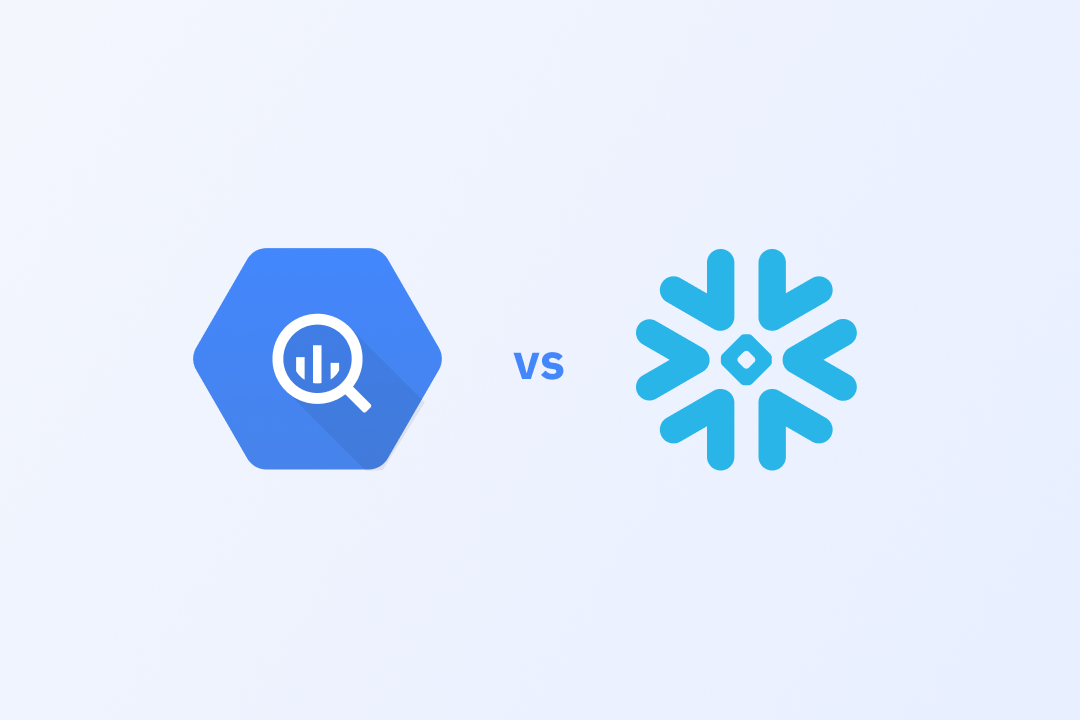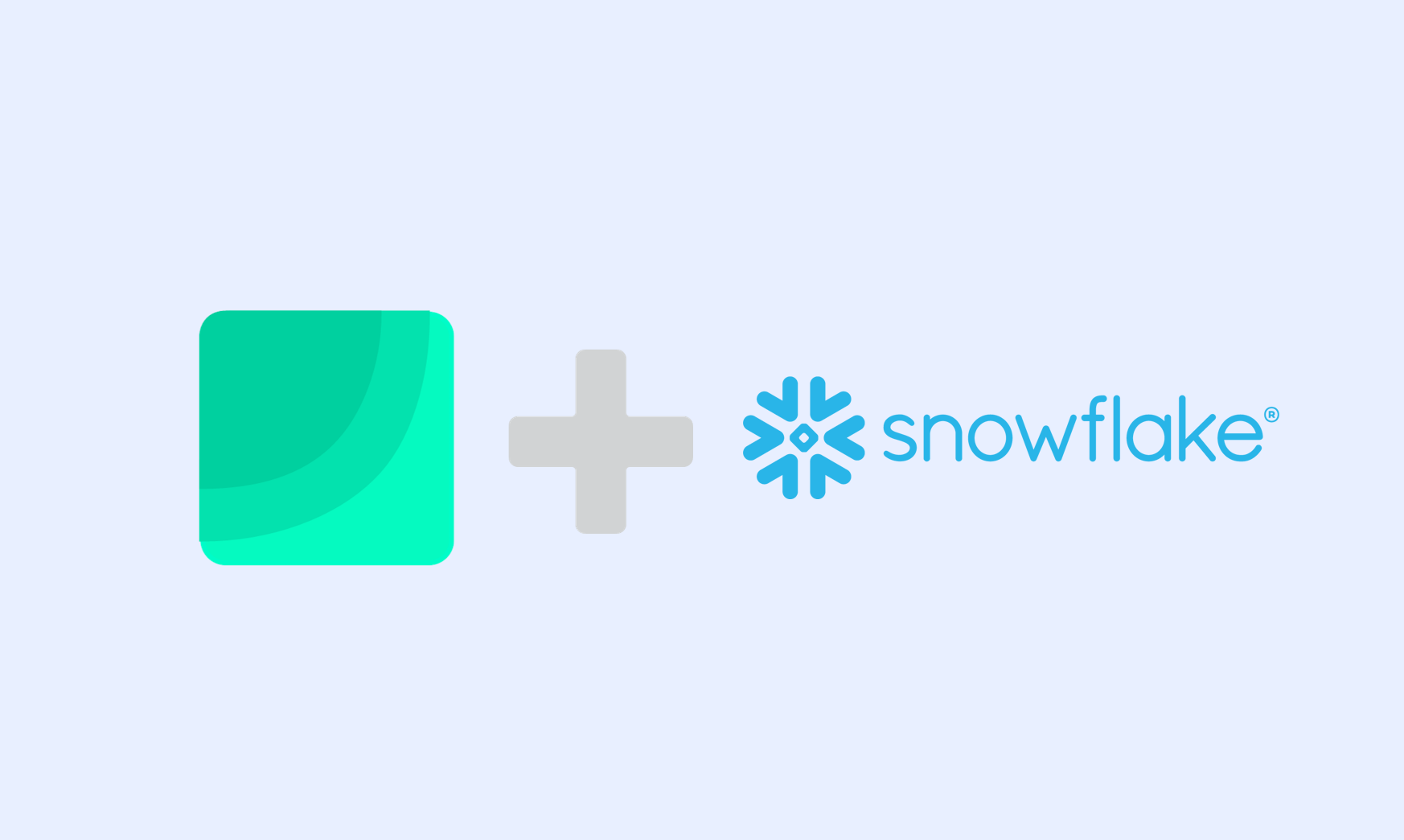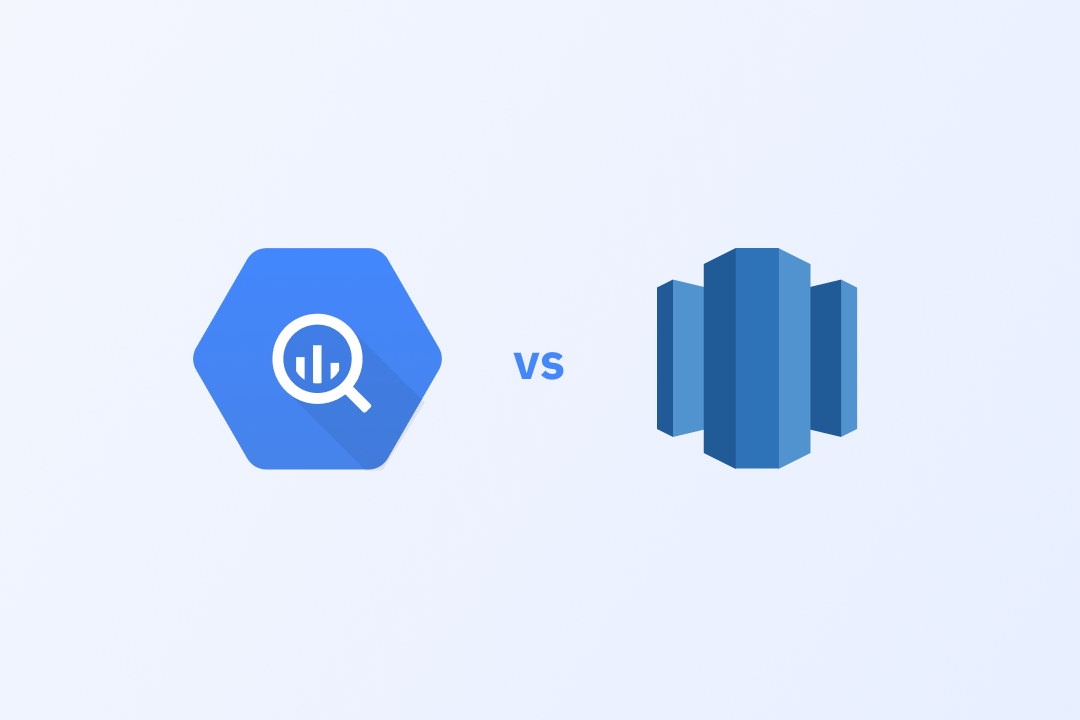BigQuery vs. Snowflake: What are they and which one to choose?
We dig deep into BigQuery vs. Snowflake and help you decide what to choose in different use cases by talking about their advantages.

You must have often heard about tools like BigQuery and Snowflake in association with terms like data warehousing or business intelligence tools. So it's clear that those are the critical terminologies behind the software, as mentioned earlier. But how do they compare with each other? Which one is better in what way? This article will answer all of these questions and more by drawing conclusions and inferences from meticulous research.
What are data warehouses?
Let's dissect the word Data Warehouse; it consists of two simple words, 'Data' and 'Warehouse'. 'Data' simply means units of facts that can drive meaningful insight. On their own, these individual units aren't of much use, so to mitigate this problem, we store these units together to derive some meaningful insights. This organised collection of valuable data is called information. While objectively, 'Warehouse' means a large storage area where raw materials or manufactured goods are stored. Deriving from this simple analogy, a data warehouse is a central repository for storing all the data from multiple sources together in a single place. Tools like BigQuery and Snowflake are not only data warehouses but also provide additional features like serverless infrastructure, ML insights, version control, and much more.
What is Snowflake, and what are its key features?
Snowflake is a software-as-a-service (SaaS)-based warehouse solution that can run on popular cloud providers like AWS, Azure, GCP, and many others. It was developed in the cloud and for the cloud. As a result, it has essentially no management or operational overhead and comes with zero baggage. Since Snowflake is a native SaaS service, it takes care of all the backend infrastructure, allowing you to concentrate on what's essential: drawing conclusions and inferences from your data. Due to Snowflake's tremendous scalability, virtually endless concurrent searches are possible. Snowflake's capability to process enormous amounts of unstructured data has significantly accelerated intelligent data analysis, enabling features like "Schema on Read" to access data in structured and semi-structured formats without requiring prior modelling. It has many parts, but some key ones are highlighted below.
Time Travel
One of the unique Snowflake characteristics is time travel. Users may follow the evolution of data through time by using the time travel feature. All accounts have access to this Snowflake feature, which is free and enabled by default for everyone. Moreover, this allows you to access the historical data in a table. Snowflake software can configure transient databases, schemas, tables, and temporary tables' time travel retention periods to 0 or 1 day for Snowflake Enterprise accounts (and higher). Time travel can extend the retention duration to 0-90 days for permanent databases, schemas, and tables.
Undrop
As long as the dropped object hasn't been system-purged, Snowflake's UNDROP command can recover it. The object can be undropped to return to its previous state. Databases, schemas, and tables are examples of objects that can be undropped. Users can use it to restore data more than once, and each version that has been dropped can be undone in reverse chronological order, such that the most recent version is restored first. This will work if the current table with the same name is renamed prior to doing the undrop action. Thus, one of the most crucial and unique Snowflake features is the UNDROP command.
Fail-Safe
Fail-Safe is yet another crucial Snowflake feature. In the event of disasters like disc failures or other hardware problems, Fail-Safe ensures that historical data is protected. In the event of a catastrophe, Snowflake offers seven days of fail-safe protection for data that Snowflake can only recover. After the time travel window has passed, the fail-safe seven-day period begins. The total recuperation time for a table with 90 days of time travel will be 97 days. Snowflake only handles it in the event of major catastrophes. This feature is enabled by default, and the consumer cannot disable it.
Sharing data between accounts
With Snowflake's Secure Data Sharing functionality, you may collaborate with another Snowflake user on particular objects (like tables) from a database without having to replicate the data. As a result, neither more storage space nor higher storage expenses are needed to store the shared data for the data consumer. The setup is straightforward, and data consumers have rapid access to the information because data sharing occurs through Snowflake's metadata store. Snowflake's data marketplace connects data producers and users that want to share free or paid data. Consumers can easily access shared data in their accounts, which they can query and mix with data from other sources as necessary.
Data exchange, which enables users to work with invited participants on data without becoming Snowflake clients, is another Snowflake use case. This makes use cases like data sharing between clients, vendors, and business partners simpler. Snowflake enables providers to generate reader accounts for data users who don't already have accounts. Consumers can access shared data with reader accounts without becoming Snowflake clients.
Caching Results
The Snowflake architecture includes caching at several levels to aid in accelerating your searches and cutting expenses. For instance, Snowflake stores the results for 24 hours in the cache when a query is executed. Therefore, granted that the underlying data hasn't changed, the results are already accessible if the same query is executed again by the same user or another account user. This is especially helpful when analyzing the data since it avoids replicating complex searches, saving time and reducing cost.
What is BigQuery and its key features?
BigQuery is a serverless, highly scalable data warehousing platform managed by Google that comes with a built-in query engine. The query engine is capable of running SQL queries on terabytes of data in a matter of seconds and petabytes in only minutes. As it is serverless, you get this performance without having to manage any infrastructure and without having to create or rebuild indices. It has many features, but some key ones are outlined below.
Serverless
As Google's BigQuery is serverless, Google does all resource provisioning behind the scenes. Hence, there is no need to manage your infrastructure, like in-house databases, servers, or query engines, and you can instead focus on data and analysis. Everything is provided and integrated into BigQuery itself. Moreover, it automatically upscales itself on the basis of the resources used, which implies there is no need to constantly observe or do vertical and horizontal scaling from time to time. Being serverless means your entire data lives in the cloud and can be accessed wherever and whenever you want, regardless of time and place.
MultiCloud Capabilities
BigQuery also comes with another valuable tool known as Omni, which allows one to analyze data across multiple clouds using standard SQL without leaving BigQuery's familiar interface. Its flexible, fully managed infrastructure allows data analysts or data scientists to have a completely seamless experience. Moreover, the cross-cloud transfer will enable you to aggregate data or train models across clouds from a single window.
Built-in ML and AI integrations
Besides aggregating all your data in a single place, BigQuery ML's integration with Vertex AI, along with pre-built and highly customizable TensorFlow models, makes it possible to train and run robust machine learning models on structured data in just a few minutes using only SQL. You may use these sophisticated tools to obtain additional insights and improve the predictive powers of your data, even if you have no prior experience with machine learning or artificial intelligence.
Spreadsheet Interface
Another prominent feature that BigQuery offers is connecting your database to Google Sheets and then querying it using your well-known sheet filters, formulas, etc. Without having to know SQL, users of Connected Sheets can examine billions of rows of real-time BigQuery data in Google Sheets. Users can effortlessly analyze big data using well-known tools, such as pivot tables, charts, and formulae, to quickly gain insights from massive data.
Convergence of Data Warehouses and Data Lakes
Using the Storage API, one can natively execute data science workloads using open source tools like Spark, TensorFlow, Dataflow, Apache Beam, MapReduce, Pandas, and sci-kit-learn on BigQuery. The Storage API has a significantly more straightforward architecture, requires less data movement, and does not require numerous copies of the same data.
BigQuery vs. Snowflake: A Succinct Comparison
Pricing:
Snowflake's architecture keeps computation, storage, and cloud services together to optimise their independent performance. For computational resources, Snowflake has a time-based pricing model, in which users are charged on a per-second basis for execution time but not for the volume of data scanned during processing. Each compressed TB of data kept costs USD 23 in snowflake storage. Snowflake Standard Edition compute costs are $0.00056 per second for each credit used, whereas Snowflake Enterprise Edition compute costs are $0.0011 per second for each credit used. Data stored in the Snowflake will be charged as per the average monthly usage per TB, or to save storage costs, you can also pay upfront per TB.
In terms of pricing, BigQuery has two options. Its on-demand model uses a query-based pricing model for computing resources. Users are billed at a rate of $5 per terabyte of processed data that their queries scan. BigQuery employs "flex slots," which are 60-second promises of dedicated query processing capacity, as a unit for a cost quotation. The flat-rate plans have 100 "flex slots" and start at roughly $2,920 per month. Additionally, Google charges $20 per terabyte every month for data storage.
Although these both use different billing methods, they both primarily consider both computation and storage. However, BigQuery storage is marginally cheaper per terabyte than Snowflake storage.
Security:
Both Snowflake and BigQuery offer customer-managed keys and use AES encryption for data. Both use role-based systems to grant access to resources. Snowflake enables federated user access through Okta, Microsoft Active Directory Federation Services (ADFS), and the majority of SAML 2.0-compliant providers. Microsoft Active Directory allows federated user access for BigQuery. Both provide OAuth 2 for permitted account access and support multi-factor authentication (MFA) without disclosing or storing user login information.
Granular permissions for schemas, tables, views, procedures, and other objects are available in Snowflake, but not for specific columns. BigQuery only offers permissions on datasets and not on individual tables, views, or columns. Virtual private networking is not supported by Snowflake natively, but it can be configured using AWS PrivateLink to link your Snowflake account to one or more AWS VPCs. With the help of the VPC Service Controls from the Google Cloud Platform, BigQuery enables you to set up a network security perimeter. Strong security safeguards that guard the confidentiality and integrity of your sensitive data are present in both Snowflake and BigQuery. Additionally, both technologies abide by industry-specific laws like HIPAA and PCI DSS.
Usability:
Beyond conventional reporting and dashboards, Snowflake has broader support for use cases. You can isolate diverse workloads to achieve SLAs thanks to its decoupled storage and computation design, which also supports high user concurrency. Snowflake does not offer interactive or ad hoc query performance because of slow data access, inadequate indexing, and poor query optimization. Additionally, Snowflake is unable to enable streaming or low-latency ingestion with intervals of less than one minute.
Similar to Snowflake, BigQuery offers support for more use cases than just reporting and dashboards. You may isolate workloads by placing each workload in a different reserved slot. BigQuery additionally offers low-latency streaming, in contrast to Snowflake, Redshift, or Athena. BigQuery doesn't have the performance to handle large-scale interactive or ad-hoc queries.
Scalability:
Snowflake allows users to scale their computation and storage resources up and down independently. It consists of automatic performance tuning and workload monitoring in order to improve query times while the platform is running. It scales very well, both in terms of data volumes and query concurrency. The decoupled storage/compute architecture supports resizing clusters without downtime and, in addition, supports auto-scaling horizontally for higher query concurrency during peak hours.
BigQuery handles the question of scalability entirely under the hood in the form of'slots'. As it is serverless, BigQuery automatically provisions additional compute resources on an as-needed basis in order to handle large data workloads. With no need to worry about the technological aspects, managing even petabytes of data in a matter of minutes becomes much more straightforward.
Performance:
Performance-wise, Snowflake often outperforms BigQuery for the majority of queries, but only marginally. In comparison to larger partitions, its micropartition storage strategy effectively searches for fewer data points. When compared to multi-tenant shared resource solutions, the decoupled storage and compute architecture's ability to segregate workloads allows data to avoid competition for resources, and the capacity to expand warehouse sizes can frequently improve performance. BigQuery performs similarly in benchmark tests, yet it regularly ranks last in most queries. We can do little to speed up BigQuery performance because it chooses how many resources the question will require on its own.
Manageability:
Neither Snowflake nor BigQuery imposes a significant administrative overhead. Each enables administrators to control user access, roles, and data security, yet performance optimisation occurs automatically. Each of them automatically scales in the background to match the needs of the moment as the data volume increases or the complexity of the queries increases. Snowflake, in particular, enables administrators to individually scale their computing and storage resources up and down, whereas BigQuery, which is "serverless," computes, stores resources, and has independent scaling capabilities. As a result, Snowflake's platform control ability and manageability are marginally higher when compared with BigQuery.
Conclusion
In a nutshell, Snowflake and BigQuery are both extremely versatile and put a lot of facilities on the table. Minuscule upkeep, along with a function of computational resources utilised paired with the volume of storage occupied, is used to determine the cost quotation for both of these solutions.
BigQuery has the potential to be more popular among consumers who are already familiar with the Google Cloud ecosystem and just want to pay for minimal upkeep. On the other hand, Snowflake may be a better alternative for people who wish for a platform-independent data warehouse with more configuration ability. Moreover, both platforms have excellent usability, while Snowflake might be a tad bit simpler to use. The serverless aspect of BigQuery, in particular, makes it simple to launch rapidly. Both Snowflake and BigQuery have highly developed scalable capabilities along with strong security safeguards that guard the confidentiality and integrity of users’ sensitive data. Finding the option that makes the most sense for your data strategy is the first step in choosing one over the other. The use case is the most influential factor in determining the choice between BigQuery and Snowflake.

